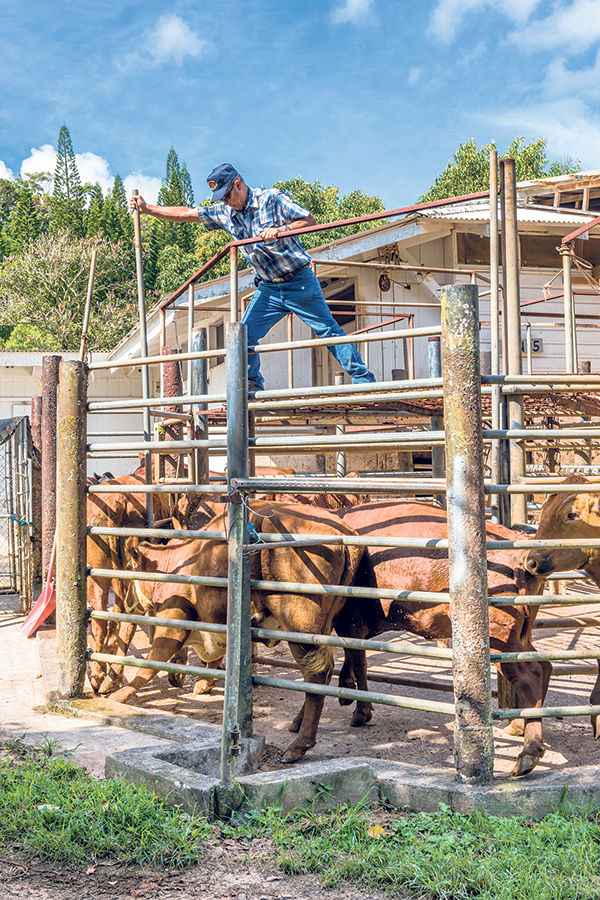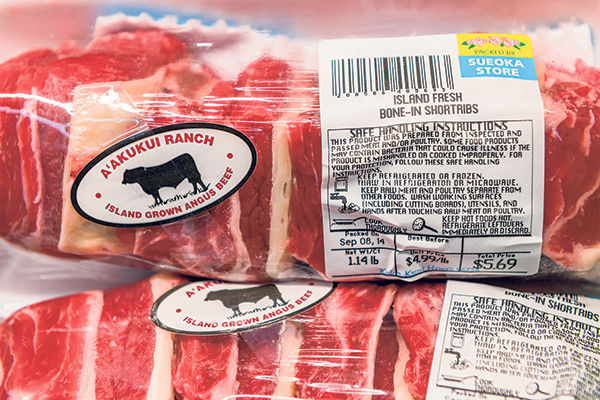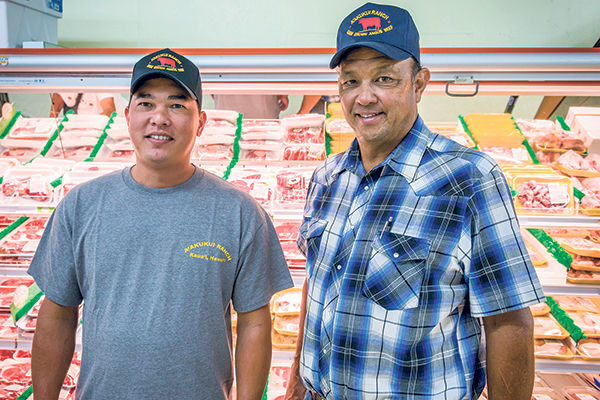Duane Shimogawa owns and operates Aakukui Ranch, which produces 100 percent grass-fed beef that is hormone and antibiotic free. About 500 cows graze on 1,750-acres of pristine pasture. Five to eight head of cattle are processed each week for island
Duane Shimogawa owns and operates Aakukui Ranch, which produces 100 percent grass-fed beef that is hormone and antibiotic free. About 500 cows graze on 1,750-acres of pristine pasture. Five to eight head of cattle are processed each week for island consumption. Quartered carcasses are delivered to local grocery stores every Wednesday, where they are butchered into 17 types of cuts, plus hamburger.
In September 2011, I covered Duane Shimogawa’s beef for the first time. In 2012 and 2013, he was the ranch chair for the Garden Island Food & Range Festival and I was the farm chair. Since we’ve gotten to know each other pretty well, he invited me to his ranch to witness the entire process, from field to grocery store shelf. I even got to be a ranch hand for 15 minutes.
My husband, Daniel Lane, and I meet Duane at his ranch on a warm Tuesday morning. Duane has already collected 20 cows, which are waiting in a corral. I, assigned with the task of sorting, sit eight feet above the chute, my left hand controlling the gate that directs immature cows into a pen on my left. If I close the gate, the cows thunder beneath me into a pen on my right. Duane, with a red flag in his left hand, directs cows two at a time while calling “straight” or “turn.” This is how I know which way to direct the cows. In short order, there are eight in the pen to my right. The cows on my left will be released into the pasture later today.
After each 1,000-pound cow is loaded into the trailer, we drive a few miles west to Andrade Slaughterhouse. Duane unloads them from his trailer into a corral. The cows will be processed in the early morning, about three hours before sunrise. Once processed, whole carcasses hang in a chilled room for seven days, which adds flavor and helps to tenderize the meat.
We follow Duane to Sueoka Store and he introduces us to meat manager, Kelly Hadama, who points out Aakukui Ranch cuts in the meat department of the family-run grocery store.
“Duane delivers about 1.5 head of cattle a week,” Kelly says. “He delivers it Wednesday morning, we process it and have it on the shelves the same day. His meat is so popular, that we usually sell out in two days.”
In all, Aakukui Ranch grass-fed beef has traveled 10 food miles, minimizing the carbon footprint while putting money back into Kauai’s economy.
Grass-fed beef
Grass-fed cattle have solid muscle tissue because they graze the hillsides, munching on blades of grass. This means it takes a little extra care to serve a steak that is tender and juicy. It’s worth the extra effort because I find grass-fed beef to have much more flavor than grain-fed beef. Plus, large amounts of chlorophyll in the cow’s diet are converted into high levels of healthy omega 3 and omega 6 fatty acids.
Season: Grass grows year-round because of the temperate conditions on Kauai, so Shimogawa’s beef is always available.
What to look for
A deep-red color, clean scent and firm texture mean the meat is fresh. Brown spots are an indication of age, and not in a good way. Fat from grass-fed beef may have a yellowish appearance from the elevated carotenoid content, which makes the fat high in antioxidants.
Storage
Store in the refrigerator for up to three days, or freeze for one month.
Tip
Take the beef out of the refrigerator 30 minutes before you plan to cook it. This gives it time to come to room temperature so it will cook evenly.
Preparation
Cooking techniques between grass-fed beef and grain-fed beef differ greatly. Since grass-fed cattle roam pastures, while grain-fed cows stand in feedlots, grass-fed beef can be dry and tough if cooked incorrectly. It can take a little more time and care, but the favor payoff, added health benefits, contribution to Kauai’s economy and minimal environmental impact make local grass-fed beef the only thing I serve in my home.
In my experience, grass-fed stew meat or other brazing cuts need to be cooked longer than many recipes call for. Since they slowly bubble on my stovetop while I write in my home office, this is not a problem for me. If you work away from home, a wonderful option is to make these types of meals during laundry day and make extra, so you can enjoy the leftovers later on in the week.
With cuts that cook quickly, such as steak, a short cooking time is best. For rare steak, cook three minutes per side. Medium-rare requires four minutes per side. Cooking grass-fed steak for more than four minutes will make it dry and tough.
Cook over high heat for optimum results. Set a pan over medium heat for 5 minutes and generously salt the steak. Turn heat to medium-high and set your timer accordingly. When finished, remove the steak from the pan and let rest for eight minutes. This allows juice to reabsorb into muscle tissue and not drain on the cutting board. For best results, slice thinly across the grain.
Health benefits
Grass-fed beef doesn’t elevate cholesterol as much as grain-fed beef, is lower in saturated fat and rich with omega 3 fatty acids, antioxidants, and vitamins A and E. Research spanning three decades suggests that grass-based diets significantly improve the fatty acid composition and antioxidant content of grass-fed beef.
Omega 3 fatty acids, which are primarily found in walnuts, fish and flaxseeds, keep skin and other tissues youthful and healthy by preventing dryness, scaling and itchiness. Omega 6 fatty acids, typically found in the seeds of land plants, transport and break down cholesterol. Too much omega 6 can cause inflammation, narrow blood vessels and promote the clotting of blood.
A study by S. Larson College of Agriculture, California State University and Chico University of California Cooperative Extension Service states that cattle fed primarily grass enhanced the omega-3 content of beef by 60 percent and also produces a more favorable omega 6 to omega -3 ratio.
Aakukui Ranch beef can be found at
Grocery: Ishihara Market, Sueoka Store, Kukuiula Market. Restaurants: Merriman’s Fish House, Poipu. For more information, call 245-2450.
•••
Marta Lane has been a food writer on Kauai since 2010. She graduated from a 12-week organic farming course on the North Shore and went on to become the farm’s Community Supported Agriculture manager. Marta is the author of Tasting Kauai: Restaurants – From Food Trucks to Fine Dining, A Guide to Eating Well on the Garden Island. For more information, visit www.TastingKauai.com.




